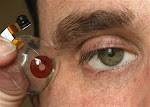 WASHINGTON-US scientists have perfected a new technique to magnify by more than 1,000 times molecules deep inside the human body which may help detect miniscule tumors, a study said Monday.The technique of non-invasive molecular imaging of small subjects uses a phenomenon known as Raman spectroscopy and the research team from Stanford University School of Medicine believes it is the first such study of its kind."This is an entirely new way of imaging living subjects, not based on anything previously used," said lead author Sanjiv Sam Gambhir.The new imaging system can show up tumors, using tiny nanoparticles injected into the body to serve as scientific beacons as they attach themselves to different tumor molecules. Raman spectroscopy is a phenomenon first discovered in the 1920s by an Indian doctor and refers to the scattering which happens when light from a source such as a laser is shone on a object.The technique is largely used in industry and research, and measures the way that the light hits the object and bounces off again.The scattering pattern which is created is known as a spectral fingerprint, and is unique to each kind of molecule, helping to determine a material's molecular composition and structure.The Stanford team believe this is the first time the technique has been adapted to provide images from inside the human body.The signals emitted by spectroscopy are stronger and last longer than those of other available methods, and could provide information about various molecules all at the same time, said Gambhir."Usually we can measure one or two things at a time," he said. "With this, we can now likely see 10, 20, 30 things at once."And these specialized particles emit signals that can be measured and then converted into a visible location of where they are in the body."The imaging modality reported here holds significant potential as a strategy for biomedical imaging of living subjects," Gambhir wrote in the study published in the Proceedings of the National Academy of Sciences.The technique could prove useful in surgery for removing cancerous tissue, as the imager is so sensitive it can aid doctors in finding even the smallest amount of malignant cells, he added.Gambhir compared the team's work to the development of the positron emission tomography discovered some three decades ago, which has become a routine imaging technique for cancer detection by creating a three-dimensional image of what is happening inside the body."Nobody understood the impact of PET then. Ten or 15 years from now, people should appreciate the impact of this," he said.The team's first tests were carried out on mice, and a clinical trial is now planned on humans using gold nanoparticles for possible use with a colonoscopy for the early detection of colon cancer.
WASHINGTON-US scientists have perfected a new technique to magnify by more than 1,000 times molecules deep inside the human body which may help detect miniscule tumors, a study said Monday.The technique of non-invasive molecular imaging of small subjects uses a phenomenon known as Raman spectroscopy and the research team from Stanford University School of Medicine believes it is the first such study of its kind."This is an entirely new way of imaging living subjects, not based on anything previously used," said lead author Sanjiv Sam Gambhir.The new imaging system can show up tumors, using tiny nanoparticles injected into the body to serve as scientific beacons as they attach themselves to different tumor molecules. Raman spectroscopy is a phenomenon first discovered in the 1920s by an Indian doctor and refers to the scattering which happens when light from a source such as a laser is shone on a object.The technique is largely used in industry and research, and measures the way that the light hits the object and bounces off again.The scattering pattern which is created is known as a spectral fingerprint, and is unique to each kind of molecule, helping to determine a material's molecular composition and structure.The Stanford team believe this is the first time the technique has been adapted to provide images from inside the human body.The signals emitted by spectroscopy are stronger and last longer than those of other available methods, and could provide information about various molecules all at the same time, said Gambhir."Usually we can measure one or two things at a time," he said. "With this, we can now likely see 10, 20, 30 things at once."And these specialized particles emit signals that can be measured and then converted into a visible location of where they are in the body."The imaging modality reported here holds significant potential as a strategy for biomedical imaging of living subjects," Gambhir wrote in the study published in the Proceedings of the National Academy of Sciences.The technique could prove useful in surgery for removing cancerous tissue, as the imager is so sensitive it can aid doctors in finding even the smallest amount of malignant cells, he added.Gambhir compared the team's work to the development of the positron emission tomography discovered some three decades ago, which has become a routine imaging technique for cancer detection by creating a three-dimensional image of what is happening inside the body."Nobody understood the impact of PET then. Ten or 15 years from now, people should appreciate the impact of this," he said.The team's first tests were carried out on mice, and a clinical trial is now planned on humans using gold nanoparticles for possible use with a colonoscopy for the early detection of colon cancer.As in the days of Noah....






















































































.bmp)

























.bmp)